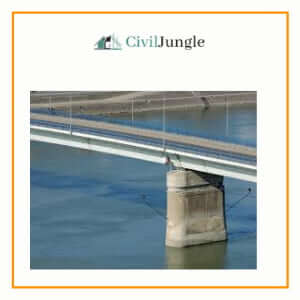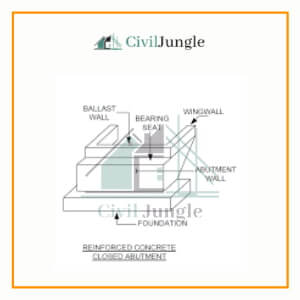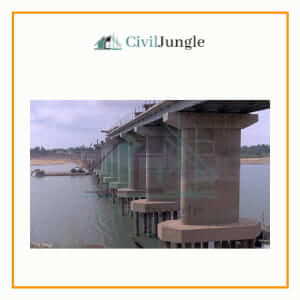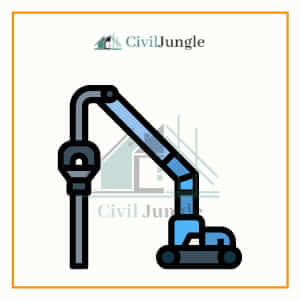What Is Bridge?
Important Point
A bridge is a system for transporting road traffic and perhaps other moving loads across a deep gorge or obstacle, including a river, a canal, a road, or a railroad.
Throughout ancient times, the first bridges are built across small streams only with aid of trees down or togs of wood. Subsequently, the Style Bridge suspension was formed by twisted creepers connected to the tree branches from either sides of the gorge.
Starting with rope as well as chain footbridges, engineering has evolved rigorously and thoroughly and is among the great accomplishments of the engineering genius of humankind.
Also, Read: How Are Bridges Built | How Are Bridges Constructed | Factors Associated with Building Bridges
Components of Bridge and Their Function
The main components of bridge are :
- Substructure.
- Superstructure.
- Adjoining Structure.
#1. Substructure Components of Bridge
The components of bridge involved in substructure of bridges are:
- Piers.
- Pier cap.
- Abutments.
- Wing Walls and the Returns.
- Foundation.
- Pile.
- Pile caps.
- Bents.
1. Piers
The piers are vertical framework components of bridge that used stabilize the deck or even the bearings required for the movement of the load to the underground soil via the foundation. Such systems act as reinforcement for bridge span at intermediate stages.
The pier structure has two major objectives:
- Move of loads to the Foundation.
- Resistance to the lateral forces.
Any of the piers are designed to withstand vertical loads on their own. In locations inside the earthquake environment, it is suggested that the pier be built for lateral loads as well.
Several of the piers are made of concrete. Steel for the building of the pier has been used in so few instances so far. Through use of composite columns, hence the steel columns packed with concrete, is seen as a modern pier building technology.
The pier is a vertical member which absorbs forces by ways of a shear mechanism. This forces are predominantly lateral forces. The pier consisting of several columns is labeled bent.
Types of Piers in Bridge Construction:
There seem to be various types of piers based on structural connection, segment form and frame layout.
- The pier could be graded as monolithic as well as cantilevered on the basis of structural connectivity.
- Dependent on the form of the segment pier, it may be categorized as solid or hollow, hexagonal, circular or octagonal, or rectangular.
- Based on the frame design, the pier may be categorized as a single or multiple column bent, a hammerhead or a pier wall type.
2. Pier Caps
Pier caps are one of the components of bridges often classified as headstocks. This serves as space for girders to pass loads on bearings (which split the load between all piers) from either the superstructure components of a bridge on the top.
Also, Read: What Is Pier Foundation | Types of Drilled Piers | Advantages and Disadvantages of Drilled Pier Foundations
3. Abutments
Abutments being components of bridge vertical structures that used keep the soil behind its building. The dead as well as the live loads of the bridge superstructure are assisted by the bridge abutments.
The abutments are often exposed to lateral stresses, primarily from the approach bank. The geometry loads on the abutment are based primarily on:
- The type of abutment you chose.
- Construction series.
- The abutments are primarily designed to survive overturning and slipping. More emphasis is on the reliability of the whole system.
Care needs to be taken to the foundations of the abutments. The base of the abutment must solve the problems of differential settling and unnecessary motions induced by lateral forces or loads.
4. Wing Walls and Returns
Structures built as an extension of the abutments to hold the earth current in the access bank are termed wing walls. Anything else, such section would have a normal angle of rest. There are retaining walls built parallel to the buttresses. This wall may be designed either completely or independently from the base wall.
Three design loads can be considered at the rear of the wall when building. This contains the following:
- The Earth Pressure of the Backfill
- A surcharge from a live load or a compacting plant
- Hydraulic loads due to saturated soil conditions
The stability of the wing wall is primarily dependent on its resistance to active earth pressures. The structural components of bridges are built and constructed to survive the stresses of the earth at rest.
5. Foundation of Bridges
The foundations are structures designed to transmit loads from piers, buttresses, wing walls as well as returns uniformly to strata.
The foundation established for bridge structures is deep enough to prevent scouring due to the flow of water or to limit the chances of weakening it.
Also, Read: What Is Well Foundation | Component of Well Foundation
6. Pile
Piles are generally placed to support the bridge as well as build up the initial base. The piles allow the weight and tension of the bridge to be spread uniformly through the earth, making it secure and solid.
Material and battery configuration rely on a variety of variables, such as soil condition, soil volatility, and load bearing capacity limit. In the case of river bridges, scouring is often required even before bridge is constructed.
7. Pile Caps
Pile Caps include extra load transfer power to the stacks. These also are recognized as pile caps, since they are put right at the top of the pile base. Caps are also constructed of very strong concrete to provide optimum protection to the roof of the bridge.
Also, Read: Piling for Foundation | Use of Pile Foundation | Characteristics of Pile Foundation
8. Bents
As the stacks and caps are placed together, they are named bents. Multiple bents form the base for the substructure.
#2. Superstructure Components of Bridge
The bridge construction superstructure components of bridge consisting of
- Girders
- Trusses
- Barrier
- Arches
- Decks
- Bearings in Bridges
- Parapets and Handrails/ Guard Rails or Curbs
This components of bridge differ depending on the bridge design (whether concrete or steel or composite). The bridge superstructure carries the load going it over. It also helps to transfer the forces generated by the loads to the substructures beneath.
1. Girders
Girders are also components of a bridge that joins together both of the pile caps by expanding across them. Girders are often related to beams that provide protection to the deck. There may be a single span, or perhaps even multiple span linking all the bents, depending on the length of the bridge.
Girders typically also have truss configuration to enhance stress as well as load resistance. Pressure is then easily transferred to the base. Girders are often made of aluminum or concrete.
Also, Read: Introduction of Gantry Girder | Load on Gantry Gutter | Types of Load on Gantry Gutter
2. Trusses
Trusses are components of bridge rendered by combining the triangular elements to separate the loads as well as bend the moments across the bridge. Other types are plain trusses, suspension, and cantilever trusses. The truss network includes a distribution surface that can be designed as a deck truss, a pony truss or a truss. Every other truss varies in the way the traffic travels on the bridge.
3. Barriers
Components of bridge that is barriers is Primarily as a safety and security element, bridges have walls on the sides of their decks. They may be custom built fixtures, chains, rails, barriers or concrete walls for improved aesthetics.
4. Arches
The bridge with the arches does have a great deal of momentum. Arches may help monitor the stability and load-bearing strength of the bridge. The amount of arches as well as material used during building is very significant.
The area between the bridge pillars as well as the deck beam is named the spandrel. Depending on the configuration of the arch, spandrels may be extended or closed.
5. Decks
The deck is components of bridge known to be the road or rail surface of the bridge. The decks are protected by the girders or the massive beams which are protected by the piers. The entire structure is backed by deep foundation, primarily piles as well as cap arrangement.
6. Bearings in Bridges
The loads obtained by the decks are conveyed correctly and securely to the substructure only with aid of the bearings. All those are components of bridge that allow even the distribution of the load mostly on substructure components of bridge material. Such transmission is particularly critical in conditions in which the substructure also isn’t built to take some action on the load.
The bearings in the bridges enable the longitudinal movement of the girders. Such movement is generated by the loads exerted in the longitudinal direction. The forces due to shifting loads as well as temperature variation are the major sources of longitudinal forces.
The choice of bearings depends on certain factors, such as acting weights, geometry, degree of upkeep, clearance required, displacement, rotation and deflection policy, affordability, manufacturer preference, construction tolerances, and cost requirements.
For the construction of the bridge, all of the considerations or components of bridge listed above are considered for the design and choice of bearings. The builder must regard the bearing structure of the bridge construction as a separate device.
In certain building activities, the bearing is chosen or the bearing decision is taken at the last minute. Such a results in a rise in maintenance in the future, which must be stopped.
7. Parapets and Handrails/ Guard Rails or Curbs
Such components of bridge would not be of structural significance, they are given for safety considerations. They are given above the decks. This would help keep the car from sliding off the bridge onto the water body below or as a way of separating the traffic streams.
Also, Read: What Does Parapet Mean | Types of Parapet Wall | Uses of Parapet Wall
#3. Adjoining Structures
It involves of the followings components:
- Guard stones.
- Approaches.
1. Guard Stones
They are utilized to limit transportation on a specific lane or occasionally as road railing but are usually located to defend an exact thing, such as a corner of a street or the side of a gate.
2. Approaches
It is organized built at the preliminary or ending of any bridge. Its chief purpose is to deliver smooth and easy entrance or leaving from a bridge.
What Is A Bridge?
A bridge is a structure built to span a physical obstacle, such as a body of water, valley, or road, without closing the way underneath. It is constructed for the purpose of providing passage over the obstacle, usually something that is otherwise difficult or impossible to cross.
Components of Bridge
The main components of a bridge are the foundation, substructure, and the superstructure. Each of these core areas have other parts are as follows,
- Deck
- Superstructure
- Substructure
- Foundation
- Girder or beam
- Bridge tower
- Pier
- Pier cap
- Bearings
- Piles
- Pile cap
- Bridge anchor
- Suspension cable
Parts of a Bridge
Diffrent types of pars are as follows.
- Substructure.
- Piers.
- Pier cap.
- Abutments.
- Wing Walls and the Returns.
- Foundation.
- Pile.
- Pile caps.
- Bents.
- Superstructure.
- Girders:
- Trusses:
- Barriers:
- Arches:
- Decks:
- Bearings in Bridges
- Parapets and Handrails/ Guard Rails or Curbs
- Adjoining Structure.
- Guard stones.
- Approaches.
What Is the Function of Bridge?
A bridge is a structure built to span a physical obstacle (such as a body of water, valley, road, or rail) without blocking the way underneath. It is constructed for the purpose of providing passage over the obstacle, which is usually something that is otherwise difficult or impossible to cross.
What Is the Purpose of Bridge?
Bridges have a special place in transportation infrastructure due its direct relationship with other places. These structures have the purpose to carry on the traffic loads of the highway, crossing any obstacle and perform an effective communication between two destinations.
Function of Bridge
A bridge is a structure built to span a physical obstacle (such as a body of water, valley, road, or rail) without blocking the way underneath. It is constructed for the purpose of providing passage over the obstacle, which is usually otherwise difficult or impossible to cross.
Arrange Correct Order of Components of Bridge from Top
The components of the bridge are picked to fit not only its use case scenario (pedestrian, highway, railway, transit or industrial bridges) but also location on which it is built, the span between its main structural beams and their basic structure (arch, beam, cantilever, cable-stayed, suspension or other).
What Is the Function of the Bridge?
A bridge is a structure built to span a physical obstacle without blocking the way underneath. It is constructed for the purpose of providing passage over the obstacle, which is usually otherwise difficult or impossible to cross.
What Is Bridge in Civil Engineering?
A bridge is a structure built to span a gorge, valley, road, railroad track, river, body of water, or any other physical obstacle. Designs may be built higher than otherwise needed in order to allow other traffic (particularly ship traffic) beneath.
Function of Bridge in Civil Engineering
Bridge, structure that spans horizontally between supports, whose function is to carry vertical loads.
Bridge Components
- Deck
- Superstructure
- Substructure
- Foundation
- Girder or beam
- Bridge tower
- Pier
- Pier cap
- Bearings
- Piles
- Pile cap
- Bridge anchor
- Suspension cable
What Is the Purpose of Bridge?
Bridges have a special place in transportation infrastructure due its direct relationship with other places. These structures have the purpose to carry on the traffic loads of the highway, crossing any obstacle and perform an effective communication between two destinations.
Bridge Components and Their Functions
- Deck: Deck is the portion that carries all the traffic.
- Superstructure: The portion supports the deck slab and girder and connects one sub-structure to the other. That means all the elements of the bridge attached to a supporting system can be categorized as superstructure.
- Sub-structure: The parts of the bridge which support the superstructure and transmit all the structural loads of the bridge to the foundations. For example, piers, abutments, etc.
- Foundation: Foundation is the portion that transmits loads to the bearing strata. Foundation is required to support the piers, bridge towers, and portal frames. Generally, piles and well foundations such as H-pile, bore piles, pipe piles, or precast concrete piles are adopted.
- Girder Or Beam: The beam or girder is the part of the superstructure which bends along the span. The deck is supported by beams.
- Bridge Tower: It is the vertical supporting part used for cable-stayed or suspension bridges. High-strength concrete and Insitu method are adopted to construct the bridge tower.
- Pier: Pier is the part of the substructure that supports the superstructure and transfers loads of superstructure to the foundations.
- Pier Cap: Pier cap is the topmost part of a pier that transfers loads from the superstructure to the pier. It is also known as headstock.
- Bearings: Bearing is a device which supports the parts of superstructure and transfers loads and movements from the deck to the substructure and foundation.
- Pile & Pile Cap: Pile is a slender member driven into the surrounding soil to resist the loads. Pile cap is a thick reinforced concrete slab cast on top of the group piles to distribute loads.
- Bridge Anchor: Bridge anchor is only used in suspension and cable-stayed bridges to resist the pull from suspension cable or counter span of the bridge.
- Suspension Cable: It is used in suspension and cable-stayed bridges for the hanging, supporting and counter balancing of the bridge deck.
Main Function of Bridge Foundation Is Provide
A Bridge foundation or Bridge Pier is provided to hold the bridge span and transmit the load to the ground. This simply means that the Bridge Foundation needs to be robust enough to not only holds the vertical load of the substructure but also hold the lateral stress of the bridge span.
Bridge Superstructure Components
The main part of a bridge is its superstructure. The superstructure bears the weight of the load as it passes through the bridge. It comprises the deck slab, girders, truss, etc. The specific components vary based on the type of bridge and its materials, such as concrete or steel.
Components of Bridge Structure
The main components of a bridge are the foundation, substructure, and the superstructure. Each of these core areas have other parts within them. Piles and pile caps are constructed as the foundation of the bridge.
Parts of Bridge
- Deck.
- Abutment.
- Pile.
- Pier.
- Girder.
- Rail Track.
Like this post? Share it with your friends!
Suggested Read –
- Types of Buttresses
- What Is a Flyover Bridge
- Civil Engineering Software | List of Civil Engineering Software | List of Engineering Software
- What Is Sewerage System | Types of Sewerage System | Why We Need a Partially Separate System | How Does a Sewage Treatment Plant Work
- What Is Kelly Ball Test | Test Procedure of Kelly Ball Test | Use of the Kelly Ball | Advantages of Kelly Ball Test | Disadvantages of Kelly Ball Test
- 9 Types of Curing | What Is Curing of Concrete | Why Curing Is Important | Minimum Curing Period for Concrete Cement | How Long Does It Take for Concrete to Dry
- What Is Micropile | Types of Micropile | Common Uses of Micropile | Advantages & Disadvantages of Micropiles | Micropile Vs Typical Pile | How Are Micropiles Installed
Originally posted 2023-01-30 12:08:55.










Leave a Reply